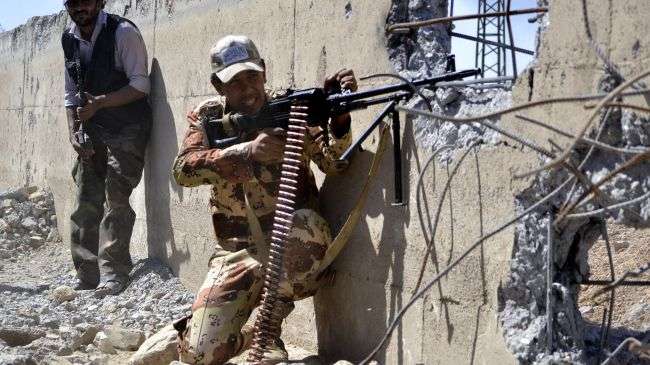(AhlulBayt News Agency) - Following Astana peace conference on Syria, which was the first outcome of the tripartite meeting of Russia, Iran, and Turkey in Moscow after strategic Aleppo liberation, the tensions and clashes among the armed opposition groups saw an intensification in their stronghold, Idlib province, particularly because the representatives of the armed opposition that joined the dialogue tacitly announced their agreement with the Astana meeting resolution including its items that insisted on fighting terrorist groups such as ISIS and Jabhat Fateh al-Sham (formerly al-Nusra Front) and drawing lines between the armed opposition groups and the Jabhat Fateh al-Sham.
In fact, before the latest peace conference, any confrontation between the Jabhat Fateh al-Sham and the armed opposition was not formal, and the opposition did not show a serious will to counter the terrorist group, but the conference pushed Jabhat Fateh al-Sham to feel a danger from the opposition groups. Just a day before end of the Astana talks, the terrorist group stepped up attacks against the opposition militants in Idlib. The assaults came as a preemptive step to intimidate the opposition and so prevent any upcoming offensives against its positions.
The first victims from the Syrian armed opposition groups were the Jaish al-Mujahedeen and Jabhat Al-Shamiyah whose headquarters in Aleppo and Idlib outskirts came under attacks of Jabhat Fateh al-Sham and were seized.
The opposition sources have told of Jabhat Fateh al-Sham’s decision to destroy at least five units of the rival armed groups which are camping in outskirts of Aleppo and Idlib. A couple of days after the announcement, the terrorist group broadened range of offensives against the opposition militants, opening new fronts in southern and northern Idlib outskirts.
The Jabhat Fateh al-Sham escalation against the militant groups that took part in Astana talks pushed them to seek new actor and a safe haven to stay protected against hostilities of the terrorist group. So an array of the opposition militant groups like Faylaq al-Sham, Idlib Free Army, Jabhat Al-Shamiyah announced joining Ahrar al-Sham militant organization. Ahrar al-Sham welcomed the joining, announcing that assaulting positions of the newly-joined groups will be considered a declaration of war and will be responded to.
Ahrar al-Sham is the strongest militant organization on the ground after Jabhat Fateh al-Sham. Nour al-Din al-Zenki Movement comes in third place, followed by Jaish al-Islam.
New groups' entry to Ahrar al-Sham created new balance of power, with gravitation of power in the battlegrounds leaning toward this group. This, in turn, raised the hackles of Jabhat Fateh al-Sham, leaving it struggling to form new alliance to restore the balance between it and the rival Ahrar al-Sham.
A new alliance was forged, dubbed Hayaat Tahrir al-Sham, or Levant Liberation Association. The bloc is led by Abu Jabber Hashem Al-Sheikh, former commander in Ahrar al-Sham. It included Nour al-Din al-Zenki Movement, Jabhat Ansar al-Din, Liwa al-Haqq, and Jabhat Fateh al-Sham itself, aiming to generate deterrence in the face of any possible offensives by Ahrar al-Sham.
Abu Jabber Hashem Al-Sheikh defected from Ahrar al-Sham after ideological differences rose with other commanders who had Muslim Brotherhood ideologies. He developed Salafist and Al-Qaeda tendencies. Between 2003 and 2005, he joined Abu Musab al-Zarqawi, former Al-Qaeda leader in Iraq.
So it can be noted that two ideological fronts are standing head to head in northern Syria areas like Idlib and Aleppo outskirts, one representing al-Qaeda's ideology and the other representing Muslim Brotherhood's thought.
Each camp is backed by a foreign supporter, or supporters responsible for supplying them financially and ideologically. Jabhat Fateh al-Sham is backed by Saudi Arabia while Ahrar al-Sham is supported by Turkey.
In fact, the recent Idlib developments can be regarded as a scene for confrontation of the two ideological camps of Salafism and Muslim Brotherhood, with each side striving after an upper hand.
Furthermore, marginalization of Saudi Arabia and Qatar in the Astana peace process played a major role in strengthened Idlib clashes. Both countries are seeking to put hurdles ahead of the solidifying peace initiative using their own pawns in the battlefield.
Hayaat Tahrir al-Sham alliance is estimated to have 15,000 fighters, while Jabhat Fateh al-Sham before the alliance had only 8,000 fighters. The rival Ahrar al-Sham bloc has about 20,000 fighters along with its affiliates. The time will show if the two opponents seek a more serious confrontation, having in mind that so far Ahrar al-Sham exercised a kind of restraint to steer clear of major fight with Jabhat Fateh al-Sham.
/298
source : Alwaght
Tuesday
31 January 2017
11:44:21 AM
808434

Before the latest peace conference, any confrontation between the Jabhat Fateh al-Sham and the armed opposition was not formal, and the opposition did not show a serious will to counter the terrorist group.
